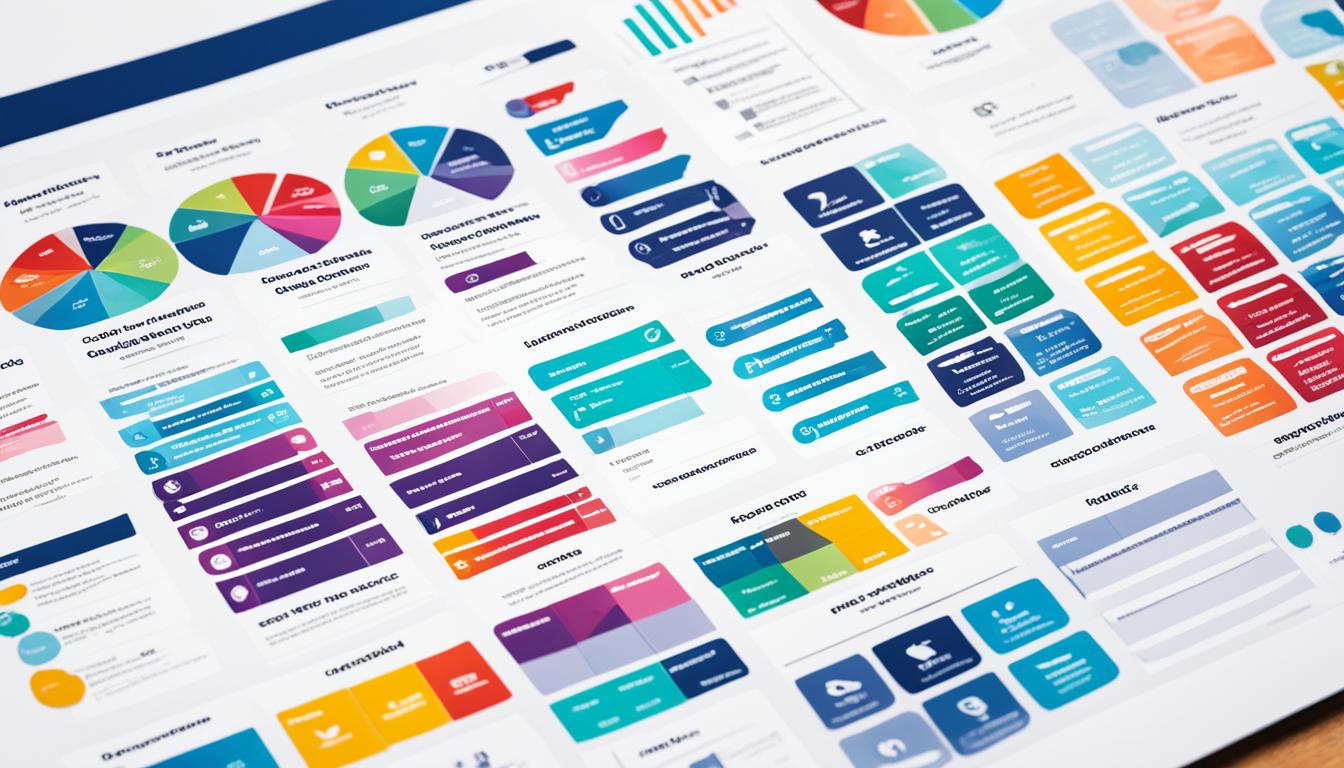Creating a strong social media plan is key to boost your online image and grow your business. Tips outlined below aim at crafting a 3-month strategy. This strategy centers on creating top-notch content. It also emphasizes engaging with your followers and making sure your profile shines. Using these tips, your social media work can turn into real business results.
Marketers know influencers can greatly increase a brand’s visibility, reaching new people. Given that social shopping’s value is expected to hit $1.2 trillion by 2025, it’s vital to be innovative. Plus, using social media data to guide your moves is smart. For instance, half of users spot new items through ads. By using tools like Sprout’s Analytics, you can see how well you’re doing compared to others.
Being organized and staying true to your brand on various platforms helps people know and remember you. With over 2 billion active users, Facebook, for example, is a prime spot for reaching out. Other platforms like Instagram, Twitter, and LinkedIn have their own unique user groups too. Make a plan that fits your goals and focuses on your target audience. This ensures a solid social media plan for the coming months.

Setting SMART goals and keeping your brand consistent help in social media success. Engaging with your followers and building trust is crucial. Regularly checking on what’s working and making changes based on actual data is key. This approach makes your social media strategy not just impactful but also valuable for your business.
Determine Your Social Media Goals
It’s crucial to set clear social media goals for your marketing. Goals like lead generation, increasing online store visits, and boosting brand recognition are key. They help in reaching real, measurable outcomes.
Setting SMART Goals
Use the SMART framework to choose your social media goals. This means goals should be specific, measurable, achievable, relevant, and time-bound. Applying this method ensures your goals fit into your bigger business plans. For example, you might aim to increase engagement by 20% in three months. You’d do this with special content and by talking regularly with your followers.
Aligning with Business Objectives
Make sure your social media goals line up with your company’s overall objectives. This connection helps create a unified strategy for meaningful results. For instance, you might see better returns on social media and more website visitors. Important metrics to watch include likes, shares, comments, and reach. This approach lets you run campaigns that really help with company goals, like improving your brand’s reputation or growing in market share.
Examples of Effective Goals
Good social media goals can make your brand more visible and influential. Some examples are increasing brand awareness through more post views and growing your audience. You could also aim to get more people visiting your website through content designed to bring in new visitors. Don’t forget the importance of connecting with your community through analyzing positive mentions and keeping track of what’s said about your brand. These actions are reflected in your social media KPIs.
Creating focused and in-sync social media goals leads to clear steps and visible success in the digital world.
Create a Social Media Content Calendar
Creating a social media content calendar can change your content game. It ensures you post consistently and strategically. You cover everything from making content to sharing it.

Benefits of a Content Calendar
A content calendar helps in many ways. It gives a clear way to share content, letting you plan weeks or months ahead. This means more time to come up with great ideas and staying on track.
It helps people trust your brand when you share regularly. This boosts how many people notice you, brings in new leads, and increases sales. Planning around events and holidays also helps you reach more people.
Elements to Include
Key things for a content calendar are what types of posts to make and how you’ll measure success. Looking at what posts do well can help you make better content. This keeps your audience happy.
Remember, most of your content should inform or entertain. Only some should sell. Splitting your posts into three parts can also keep things interesting. Share what your fans make, talk with them, and sell your stuff in turns.
Using Tools to Streamline
There are many tools to help with content calendars. Sprout Social, Planable, and Kontentino are a few. They help with how often you post, planning, and getting posts approved. This makes teamwork easier.
Using data and market research can also improve your plan. Platforms like Facebook, Instagram, and LinkedIn can tell you what your audience likes. Good calendars will also let you set post times and use the best terms, so more people see and like your posts. No matter the tool, the aim is the same: better, smarter content planning that saves time and works well.
Understand Your Target Audience
Knowing your target audience well is key for a strong 3-month social media plan. The first 30 days are very important. You learn about the company and what challenges and chances are there. This info is the bedrock for making customer personas. These personas help direct your content and social media plans.

Looking into who your audience is includes details like their ages, whether they are male or female, and what they like. This helps companies speak in ways that mean something to their audience. It beats guessing. Your customer personas should include what kinds of jobs they have, what they like, how they use social media, what online groups they’re part of, and how much money they spend.
It’s vital to keep on looking and checking as things change. This keeps your goals in tune with what your audience wants. Things like listening to what’s happening on social media, checking out what your competitors are doing, and reading up on your industry all help. This makes your audience research deeper. It lets you fine-tune your plans. And that can bump your brand’s notice up by 10%, or make your social media efforts 20% better.
Having SMART goals like answering online questions in 24 hours or finding 20 good leads each month turns the spotlight on your audience. It helps in focusing your actions. This careful way of getting to know your audience leads to better social media work. It always brings good outcomes. This also means thinking deeply about who your audience is and how to best reach them.
Utilize Social Media Analytics
Adding social media analytics is key to knowing your audience’s likes and dislikes. It lets you check how well your campaigns are doing. With data-backed strategies, you can tell what’s working and what needs a boost.

Tracking Engagement Metrics
Keeping an eye on how engaged your audience is shows the success of your social media actions. Metrics like how many people you reach and the leads you get offer insights. Tools such as Google Analytics and platform insights give you the real numbers.
Interpreting Data for Strategy Adjustments
Looking at the data helps tweak your strategies the right way. You can see what content does well and how people interact with you. By doing this, companies can change their tactics for better outcomes. Figuring out what content, like videos or images, people like most is crucial.
Tools for Analyzing Performance
We have many tools to fully check and judge your social media progress. Platforms like Hootsuite, Sprout Social, and built-in analytics help a lot. These aid in a strategy that uses data to meet big goals.
Optimize Your Social Media Profiles
Starting with a great social media profile is key for good branding. It makes a strong first impression. Every part of your profile helps people recognize your brand. It also helps with your marketing goals.
Consistent Branding
It’s important to keep your branding the same on every platform. Make sure your profile pictures, cover photos, and colors all match. This makes your brand look unified. It also helps people remember your brand better.
Complete Profile Information
Post all the details on your profile. This means your business name, how to contact, and a link to your site. Write descriptions that are helpful and interesting. They should show what’s unique about your brand.
Profiles with all the right info will interest more people. They help build trust too. Remember to share your posts at the best times. Also, use carousel posts to get noticed more.
Utilizing Keywords for SEO
Using the right SEO keywords will help more people see your profile. These words can draw in visitors from search engines. It’s also important to tweak your bio with terms customers might search for. This can boost your profile’s visibility.
Use hashtags wisely. Each post should have 3-5. This prevents your content from looking like spam. Keep an eye on how your posts perform. Then, adjust your strategy. This will help improve how well your social media works for you.
Engage with Your Audience
Engaging with your audience on social media is key for a lively community. It’s more than just posting. It’s about joining the talk. The 2022 Sprout Social Index™ shows 66% of people love short videos the most. This shows how important fun, varied content is for community engagement.

Knowing your buyers helps shape your social media plan. It lets you make content that fits their needs. When you know what they like, you can create posts that start customer conversations. People like when brands show their stuff and share stories.
Using tools like Sprout for scheduling posts can make you reach more people. Also, listening tools catch what people are saying. This lets you answer fast, which is what 71% of Facebook users want after asking a brand a question.
It’s important to check how your posts do, so you know what works. This makes your talks better and more interesting. Sharing what fans make, doing polls, and showing what you do every day are great ways to get fans talking.
So, talking with your fans in smart ways is how you keep a great relationship going. It’s vital for a strong social media plan. It encourages people to chat and stay loyal. This keeps them coming back for more.
Select the Right Platforms for Your 3 Monthly Social Media Plan
When you make a 3-month social media plan, choosing the right platforms is key. You want to reach as many people as possible. Each platform is best for different types of people. This makes sure your plan lines up with what you aim to achieve.
Analyzing Demographics
Facebook has the most users, with 3.05 billion checking in monthly. If you want to chat with people, WhatsApp has 2.78 billion users who love to talk. Facebook is great for everyone, while Snapchat’s 750 million mostly are teens. This thinking helps you talk to the right folks better.

Choosing Platforms Based on Business Type
It’s important to know what your business does to pick the right platforms. If you have cool photos or videos, Instagram is for you with its 2.04 billion users. YouTube, with its 2.49 billion users, is great for videos.
Remember, if security matters, Telegram (with 800 million users) is perfect with its safe chat. This way, you’ll share your stuff where your people like to hang out the most.
Integrating Various Platform Strategies
Using more than one platform can really boost your plan. You can share across Facebook, YouTube, and Instagram together. A tool like Planable helps you post on all these at once.
Also, mixing TikTok (with its 1.22 billion users) and Instagram gives you a big impact in different ways. This keeps your message strong and reaches even more people.
Experiment with Different Content Types
Trying out different content types is key. It helps your content reach more people and meets various tastes. It can make more folks interact with your content and maybe buy what you offer.
Visual vs. Text Content
Visual content like images and diagrams attracts people quickly. It’s also easy to share online. Text-based posts, on the other hand, dive deeper into topics.
So, using a mix of both can help reach different folks in your audience.
Using Video and Live Streams
Video marketing is big now. Sites like YouTube and TikTok prove that people love watching short videos. They’re great for catching the eye.
Also, going live on Facebook or Instagram lets you talk to users in real time. This makes your brand more real and builds trust.
Interactive Content Ideas
Interactive posts such as polls and quizzes are fun and engaging. They give you insights into what your audience likes.
They do more than just engage. They also get shared a lot, boosting your visibility and making your social media lively.
Monitor Competitors’ Social Media Strategies
Keeping an eye on your rivals’ social media moves is vital for staying ahead. Checking out what they do helps you see new trends and ways to stand out. By comparing your efforts with the best, you learn what can make your strategy stronger.

Companies often do a close check on competitors every few months. They use tools like Sprout Social to see how they’re doing on Facebook, Twitter, and Instagram. A SWOT analysis also comes in handy for spotting where you can improve.
It’s key to look at things like how many followers they have or how people interact with their posts. For details on their website performance, tools like SEMRush and Ahrefs can help you see their SEO stats. There are also sites like Phlanx and Social Blade to watch how fast they’re getting new followers.
Special software makes it easier to collect data on the competition. Using a template for analysis can make this even simpler. Google Adwords Keyword Planner is great for finding the right words to use and seeing how tough the competition is for those words.
When it comes to detailed looks at the main rivals, focus on the top few. Tools such as Facebook Audience Insights and X Analytics show what brands your audience is into. This can guide you in making content that’s more appealing. Also, Semrush Social’s Social Tracker provides a lot of data on how well competitors are doing on social media.
Getting these insights helps you fine-tune your own social media plan. This keeps you sharp and ready to roll with any market shifts.
Define Your Brand Voice and Messaging
Defining your brand voice and messaging helps you connect with your audience. It makes your brand stay the same on social media, which 72% of businesses think is key. We’ll talk about how to keep your voice the same, make messages that people love, and create guidelines for your content.
Developing a Consistent Tone
Keeping your tone consistent is important. This is because 89% of consumers trust a brand more when its voice sounds the same on all platforms. Your tone should be part of your brand’s personality. It should change a bit depending on who you’re talking to and where. Having guidelines for the way you write, speak, and the message you send can make your strategy strong. It’s also good to adjust your tone to stay real and draw people in, as 84% of professionals agree.

Crafting Messages that Resonate
Making messages that really hit home builds loyalty and gets people more engaged. And 68% of consumers say a consistent voice helps show a brand’s true colors, making it easier to connect with. Tailoring your messages with help from social media stats is key. Knowing what people like on each platform makes your content more powerful, according to 82% of marketers.
Guidelines for Content Creation
Having solid content guidelines makes all your social media sound the same. This is why 76% of brands work hard to keep their voice steady. Make a document that talks about your voice and the style of your writing for different types of content. These steps really stand out to 93% of consumers, helping them remember and understand your brand better.
Leverage Paid Social Media Advertising
Paid ads on social media help businesses a lot. They make organic efforts better by reaching the right people. This leads to good results, thanks to precise targeting and clear metrics.
When to Use Paid Ads
Use paid ads to boost your brand, get more visitors, and sell more. Facebook and Instagram are great for different goals like making people aware, getting them to your website, or selling products. Instagram stands out for ads that are fun and really get people’s attention.
Targeting the Right Audience
It’s super important to aim ads at the right people. LinkedIn, for instance, lets you reach nearly a billion professionals. You can focus on folks who make the big decisions in their fields. Insights from ads also help you understand and do better for your target group.
Measuring Ad Success
Seeing if your paid ads are working involves looking at key numbers. These include CPC, CPA, ROAS, and ROI. Watching and improving these metrics as you go helps make ads better and more effective. Videos are great for grabbing people’s attention in these ads.
Evaluate and Adjust Your Strategy Regularly
Checking and tweaking your social media plan often keeps your company ready for change. It makes sure you react well to what your viewers do, how the platforms change, and what other businesses are doing. This way, you always make your plan better and better. For example, using apps like Instagram, TikTok, YouTube, and Facebook can help your brand a lot by getting customers involved.
Set SMART goals for your media plan. They should be specific, measurable, achievable, relevant, and time-bound. This helps you focus on clear targets and real results. Keep an eye on things like how many people see your posts, how many click on them, and what they say about your brand. Doing this every day and looking more closely every month means you can hit your goals and adjust your plan quickly.
Try using flexible ways to market yourself. This includes things like viral ads, building trust, working with popular influencers, and launching new products. Adjusting to new trends and feedback helps meet changing customer needs. It keeps your brand important to them.
It’s key to know who you’re talking to online. Do surveys, talk to people, check what similar companies are doing, and study social media data. This makes it easier to make content and plans that grab their attention. Creating profiles of your customers can help you make marketing that’s right on target. Just think, more than 4.62 billion people use social media. That’s a big chance to reach out with your message.
Also, going deep into the data can show you more than just the basics. Looking closely helps you find out what really works. The advice from this info is important for choosing the best steps for your social media plan. Monthly updates often show things like how much people are interacting with you online and if you’re getting new followers. Tools like Brandwatch and Mention help with this, keeping you always on track with your big goals.
In short, always reassessing and fine-tuning your social media plan, adding in flexible marketing moves, helps keep your online efforts strong. It makes sure you’re doing well against the competition and able to reach more people who are interested in what you offer.
Staying on top of how you’re doing on social is a non-stop job. It means always making sure your plan is doing its best with changes and smart choices based on data.
Conclusion
A 3-month plan for social media needs many parts to work well. It should have clear goals, planned posts, know the followers well, watch how things are going, use social media ticks, talk with people, choose the right social media, try different posts, know what others are doing, stand out, and sometimes use ads. Doing all this can help a business do better on the internet.
Studies show most people follow brands online to see new things they are offering. This shows how important it is to share useful and new stuff. Also, many want real conversations rather than just being sold to. It means brands should try to talk with people in a friendly and honest way.
Using reports from social media can help a lot. They let businesses see what’s working and where they could do better. This helps in keeping an eye on the plan and changing things as needed. Making smart choices using this data can show how well a business is doing online.
Sharing the main lessons and plans for the future in these reports is key. It can really help a business stand out online and do well. So, it’s super important to use these tools and keep learning. This can make a social media plan really go far and help a business be strong online.
FAQ
What are the key components of an effective social media strategy?
An effective social media strategy includes several key elements.
These are clear goal setting, targeted content calendars, and understanding the audience well. It also requires analyzing data, optimizing profiles, and active engagement. Selecting the right platforms, experimenting with content, and knowing your competitors are important too. So is having a unique brand and using paid advertising. Always evaluate and be ready to adapt your strategies.
How do I set SMART goals for my social media plan?
Setting SMART goals means making objectives that are Specific, Measurable, Achievable, Relevant, and Timely. These should support your business’s overall goals. They guide you clearly and help measure success, boosting your social media impact and engagement metrics.
What benefits can I expect from using a social media content calendar?
Using a content calendar brings many benefits. It helps you post in a structured and strategic way. This leads to better engagement and more effective content delivery. You can also align your posts with important dates for your audience.
Why is understanding my target audience important for social media success?
Knowing your audience well is crucial. It lets you create content that really connects with them. You can pick the right social media platforms and shape your messages. This ensures that your interactions are targeted and drive results.
What tools can I use to track and analyze social media performance?
There are many tools available. Google Analytics, platform insights, and software like Sprout Social can help. They track metrics like engagement, reach, and conversions. This data is key for tweaking your strategies and improving results.
How can I optimize my social media profiles for better engagement?
To optimize your profile, focus on branding and relevant, updated info. Use SEO keywords strategically. This makes your profile easier to find and more appealing to visitors, strengthening your online presence.
What are some effective ways to engage with my audience on social media?
Engagement is about sparking conversations and responding to your followers.
Create content that involves your audience, like with polls or responding to comments. This builds community and loyalty.
How do I choose the right social media platforms for my business?
Choosing the right social media platforms means looking at their demographics and seeing how they fit your business. Using multiple platforms with tailored strategies can increase your impact and reach.
How can I diversify my social media content effectively?
To diversify, mix up your posts with visuals, videos, and interactive content. Videos and interactive posts like polls attract different audiences and increase engagement.
Why is monitoring competitors’ social media strategies important?
Watching your competitors helps you keep up with trends and stay innovative. It shows you what works, what doesn’t, and how to stand out.
How can I develop a consistent brand voice and messaging strategy?
Develop a brand voice that’s consistent and appealing to your audience. Set guidelines for content to keep your messaging strong across social media.
When should I use paid social media advertising, and how can I measure its success?
Use paid ads when you want to boost specific content or target audiences. To measure their success, look at detailed ad metrics and consider ROI. Adjust your ads for better outcomes over time.
Why is it important to regularly evaluate and adjust my social media strategy?
Evaluating your strategy regularly keeps it effective and up-to-date. It helps you respond to changes in your audience, the platforms, and the competition. This keeps your strategy working well and your vision clear.

More Posts
7 Effective Time Management Tips for Job Seekers
Looking for a job can feel overwhelming. Yet, managing your time well can make it better. To be more productive, create a daily plan that includes job searching and personal activities. Set goals...
Top 10 Benefits of Smart Planners for Businesses in 2026
 Our lives have become so fast-paced it all seems like a haze. The more work you have, the more difficult it is to manage. Situations are worse for business owners with countless...
Fixed Schedule Pros and Cons: A Comprehensive Overview
A fixed schedule means workers follow the same timetable every day. This helps with being on time and keeps things running smoothly. It starts with planning out the work hours and days for...
10 Best Digital Hourly Planners for Smooth Routine
Ever felt overwhelmed by your daily tasks? Welcome to the world of digital hourly planners. These tools don’t just help you manage your to-do list; they’re game changers in achieving the perfect balance...